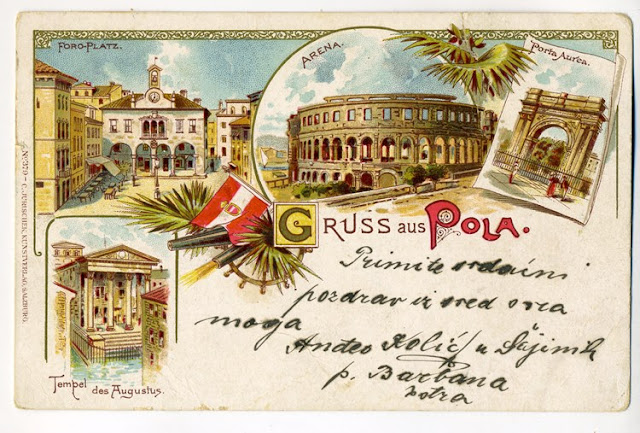Historic and Contemporary Impressions of Pula and Trieste
Author: Ross Cameron
Joyce continues to sit outside his old place of work.
When working as a language tutor at the Berlitz School in Pula in 1904, James Joyce complained, ‘I hate this Catholic country with its hundred races and thousand languages’. According to the Irish novelist, the city, which served as the headquarters for the Austro-Hungarian Navy, was ‘a back-of-God-speed place – a naval Siberia … swarming with faded uniforms’. Joyce has been immortalised in a statue next to the language school in which he taught (the yellow building beside the Arch of the Sergii) but early twentieth century British travellers to Pula generally had more favourable impressions. Most visitors admired the city’s Roman heritage with the Scottish historian Horatio Brown claiming that ‘No monument of ancient Rome, not the aqueducts of the Campagna, nor the baths of Caracalla, conveys a more impressive sense of the solid splendour of Roman architecture than does this arena at Pola’.
The number of British visitors to Pula was a key reason why I chose to undertake a Scottish Graduate School for Arts and Humanities Visiting Doctoral Researcher (VDR) stay at the city’s Juraj Dobrila University. Working in a café on the ancient forum looking at the Temple of Augustus (an obligatory stop for Victorian and Edwardian visitors) certainly provides inspiration for writing my PhD thesis on British travellers to southeastern Europe, even if they were occasionally disappointed by the intrusion of modern naval infrastructure on the ancient scene. Thomas George Bonney, writing about the temple in the 1890s, found that the ‘docks and cranes, factories and shipyards’ recalled ‘another Woolwich or Chatham’, the principal naval dockyards in London. Today, the docks at Pula are lined with tourist boats offering excursions along the coast to the Brijuni Islands, Rovinj and Poreč and it is hard to imagine the city as the naval fortress it once was in which Alice Lee Moqué claimed tourists were forbidden to take photographs in case they were British spies!
Collections of rare travelogues in the University library
Another reason for choosing to conduct my VDR stay in Pula are the collections of rare travelogues held in libraries and archives in the city and wider region. The university library holds an extensive collection of travel books about Istria, such as Thomas Allason’s Picturesque Views of the Antiquities of Pola (1819), which alerted British tourists to the attractions of the city, and copies of newspapers dedicated to promoting tourism in the region, such as the Riviera Zeitung and Adria. The Marine Library, housed in the former Naval Casino for officers and civilians employed by the Austro-Hungarian Navy, also houses an extensive but under-researched collection that I am looking forward to exploring further during my time in Pula.
The Marine Library in Pula (housed in the former Naval Casino)
I have also undertaken a research trip to the Attilio Hortis Civic Library in Trieste where I examined Maude Anne Lincoln’s A Journey to Dalmatia, a rare self-published travelogue. Recounting a cruise down the eastern Adriatic in 1912, this book includes descriptions of Pula and the Brijuni Islands, which the author describes as ‘the centre of the fashionable world’. Visiting Trieste was fascinating as it was the departure point for most British travel writers visiting Istria and Dalmatia. Although today its waterfront is relatively quiet (beyond the Russian oligarch Andrey Melnichenko’s impounded super-yacht which sits just offshore), the grand buildings on Piazza Unità d’Italia that housed the headquarters of Austrian Lloyd shipping company mean that it is not too hard to imagine the city in its nineteenth century heyday as the largest commercial port of Austria. Frederick Hamilton Jackson wrote about city in 1908 and recalled that ‘the blue [sky] was stained by the smoke of steamers and flecked with the many-coloured sails of other craft, while in the middle-distance populous Trieste stretches round the curve of the bay, with many vessels at its wharves, and the smoke from the Lloyd-Arsenal mingling with that from the ironworks’.
The Grand Canal in Trieste is quieter than it was in Hamilton’s day.
In the coming weeks, I am planning a research trip to Rijeka as well as other excursions around Istria in the footsteps of British travel writers. I will also be hosting a guest lecture at Juraj Dobrila University of Pula on British travel writing about the eastern Adriatic that is open to all students and academics interested in the topic to attend on 24 April. For further information about my research, follow me on Twitter.






Primjedbe
Objavi komentar